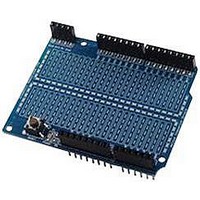AMICUS18-COMPANION-SHIELD AMICUS, AMICUS18-COMPANION-SHIELD Datasheet - Page 11

AMICUS18-COMPANION-SHIELD
Manufacturer Part Number
AMICUS18-COMPANION-SHIELD
Description
Amicus18 Companion Shield
Manufacturer
AMICUS
Datasheet
1.AMICUS18-COMPANION-SHIELD.pdf
(49 pages)
Specifications of AMICUS18-COMPANION-SHIELD
Silicon Manufacturer
Microchip
Core Architecture
PIC
Core Sub-architecture
PIC18
Features
USB Interface, In Circuit Serial Programming Interface
Kit Contents
Board
Silicon Family Name
PIC
Silicon Core Number
PIC18F25K20
Rohs Compliant
Yes
Lead Free Status / RoHS Status
Lead free / RoHS Compliant
For Use With
PIC18F25K20 Microcontroller
Amicus18 Companion Shield
We need a 47Ω resistor, so if we look at the colour table we see that we need 4 in the first band, which
is Yellow, followed by a 7 in the next band which is Violet and we then need to multiply this by 100
rd
which is Black in the 3
band. The final band is irrelevant for our purposes as this is the tolerance. Our
resistor has a gold band and therefore has a tolerance of ±5% which means the actual value of the re-
sistor can vary between 46.5Ω and 47.5Ω. We therefore need a resistor with a Yellow, Violet, Black,
Gold colour band combination which looks like this:
If we needed a 1K (or 1 kilo-ohm) resistor we would need a Brown, Black, Red combination (1, 0, +2
zeros). If we needed a 570K resistor the colours would be Green, Violet and Yellow.
In the same way, if you found a resistor and wanted to know what value it is you would do the same in
reverse. So if you found this resistor and wanted to find out what value it was so you could store it
away in your nicely labelled resistor storage box, we could look at the table to see it has a value of
220Ω.
The LED
The final component is an LED, which stands for Light Emitting Diode. A Diode is a device that permits
current to flow in only one direction. So, it is just like a valve in a water system, but in this case it’s let-
ting electrical current to go in one direction, but if the current tried to reverse and go back in the oppo-
site direction the diode would stop it from doing so. Diodes can be useful to prevent accidental connec-
tion of a Power supply in a circuit, and damaging the components.
An LED is the same thing, but it also emits light. LEDs come in all kinds of different colours and bright-
ness’s and can also emit light in the ultraviolet and infrared part of the spectrum (like in the LEDs within
a TV remote control).
If you look carefully at the LED you will notice two things. One is that the legs are of different lengths
and also that on one side of the LED, instead of it being cylindrical, it is flattened. These are indicators
to show you which leg is the Anode (Positive) and which is the Cathode (Negative). The longer leg gets
connected to the Positive Supply (3.3 volts) and the leg with the flattened side goes to Ground (Gnd).
If you connect the LED the wrong way, it will not damage it,
but it is essential that you always place a resistor in series
with the LED to ensure that the correct current gets to the
LED. You can permanently damage the LED if you fail to do
this.
As well as single colour LEDs you can also obtain bi-colour
and tricolour LEDs. These will have several legs coming out of
them with one of them being common (i.e. common anode or
common cathode).
10
Crownhill AssociatesLimited 2009 - All Rights Reserved
Version 1.0
06-10-2009











